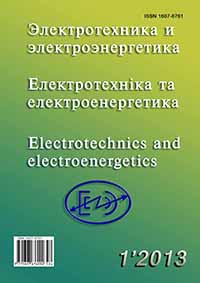ON THE QUESTION OF THE DEVELOPMENT OF DIAGNOSTIC SYSTEMS OF ELECTROMECHANICAL SYSTEMS OF COLD ROLLING MILLS
DOI:
https://doi.org/10.15588/1607-6761-2013-1-6Keywords:
diagnostic system, electromechanical system, cold rolling milAbstract
One of the ways to improve the reliability of technical systems that are widely used in practice, is to increase the level of reliability. Therefore, the actual problem is to improve the means of technical diagnostics by increasing speed of decision making diagnostic complex, studies of possible states of the individual technical components and interconnected electro-mechanical systems of cold rolling with the mutual influence of the thickness coordinate drives and tension rolled strip. Purpose of work is to show the prospects of diagnostic systems of electromechanical systems of cold rolling mills. The use of structural scheme of the proposed advanced technical means of diagnosing electromechanical systems of cold rolling mills, as well as the use of different methods of data processing, such as the fast track search channel measurements with an extreme level of the signal, which can be implemented on a high-speed microprocessor devices, will increase the development of electromechanical diagnostics systems of cold rolling, improve the speed and quality of diagnostics electric drives rolling mill.References
Гуменюк В. М. Надежность и диагностика электротехнических систем / В. М. Гуменюк. – Владивосток: Изд-во Дальневост. гос. тех. ун-та, 2010. – 218 с.
Полилов Е. В. Опыт разработки и внедрения систем регистрации электрических процессов и событий электроприводов линии стана / Е. В. Полилов, А. Б. Зеленов // ВісникКДПУ. – Кременчук : КДПУ, 2005. – Выпуск 4/2005 (33). – С. 9–11.
Пуляев В. И. Цифровые регистраторы аварийных событий энергосистем / В. И. Пуляев, Ю. В. Усачев. –М.: НТФ «Энергопрогресс», 1999. – 80 с.
Осипов О. И. Техническая диагностика автоматизированных электроприводов / О. И. Осипов, Ю. С. Усынин. – М.: Энергоатомиздат, 1991. – 160 с.
Пирожок А. В. Диагностирующий многоканальный комплекс стана холодной прокатки / А. В. Пирожок, Е. С. Назарова, О. О. Супрун, А. Г. Маринченко // Вісник КДПУ. – Кременчук : КДПУ, 2008. – Выпуск 4/2008 (51). – Ч. 1. – С. 117–122.
Назарова Е. С. Исследование электромеханических процессов дрессировочного стана с помощью диагностирующего многоканального комплекса // Вісник КДПУ. – Кременчук: КДПУ, 2009 –Выпуск 3/2009 (56). – Ч.1. – С. 103–106.
Жуков С. Ф. Система диагностирования электротехнического комплекса автоматического управления непрерывным станом холодного проката / С. Ф. Жуков, А. А. Шамрай // Спецвыпуск журнала «Техническая электродинамика». – 2010.–Ч. 3.–С. 165–168.
Закладной А. Н. Средства функциональной диагностики энергоэффективности электромеханических систем / А. Н. Закладной, В. М. Чермалих, О. А. Закладной // Електромеханічні і енергозберігаючі системи. Тем. вип. наук.-виробн. журналу. – Кременчук : КрНУ, 2012. – Вып. 3/2012(19). – С.161–162.
Бабій С. М. До питання діагностування автоматичних керуючих пристроїв електропривода / С. М. Бабій, О. Д. Фолюшняк // Зб. наук. праць VIII Всеукр. наук.-техн. конференції молодих учених і спеціалістів у м. Кременчук 08–09 квітня 2010 р. – Кременчук, КДУ, 2010. – С. 344–345.
Downloads
How to Cite
Issue
Section
License
Copyright (c) 2017 E. S. Nazarova

This work is licensed under a Creative Commons Attribution 4.0 International License.
Creative Commons Licensing Notifications in the Copyright Notices
Authors who publish with this journal agree to the following terms:
Authors retain copyright and grant the journal right of first publication with the work simultaneously licensed under aCreative Commons Attribution License that allows others to share the work with an acknowledgement of the work's authorship and initial publication in this journal.
Authors are able to enter into separate, additional contractual arrangements for the non-exclusive distribution of the journal's published version of the work (e.g., post it to an institutional repository or publish it in a book), with an acknowledgement of its initial publication in this journal.
Authors are permitted and encouraged to post their work online (e.g., in institutional repositories or on their website) prior to and during the submission process, as it can lead to productive exchanges, as well as earlier and greater citation of published work.

